Synergistic Effects of Sm and C Co-Doped Mixed Phase Crystalline TiO2 for Visible Light Photocatalytic Activity
Abstract
:1. Introduction
2. Results
3. Discussion
4. Materials and Methods
5. Conclusions
Acknowledgments
Author Contributions
Conflicts of Interest
References
- Fujishima, A.; Rao, Y.N.; Tryk, D.A. Titanium dioxide photocatalysis. J. Photochem. Photobiol. C Photochem. Rev. 2000, 1, 1–21. [Google Scholar] [CrossRef]
- Yang, C.C.; Yu, Y.H.; Linden, B.V.B.; Wu, J.C.S.; Mul, G. Artificial photosynthesis over crystalline TiO2-based catalysts: Fact or fiction. J. Am. Chem. Soc. 2010, 132, 8398–8406. [Google Scholar] [CrossRef] [PubMed]
- Schneider, J.; Matsuoka, M.; Takeuchi, M.; Zhang, J.; Horiuchi, Y.; Anpo, M.; Bahnemann, D.W. Understanding TiO2 photocatalysis: Mechanisms and materials. Chem. Rev. 2014, 114, 9919–9986. [Google Scholar] [CrossRef] [PubMed]
- Tang, J.W.; Durrant, J.R.; Klug, D.R. Mechanism of photocatalytic water splitting in TiO2. Reaction of water with photoholes, importance of charge carrier dynamics, and evidence for four-hole chemistry. J. Am. Chem. Soc. 2008, 130, 13885–13891. [Google Scholar] [CrossRef] [PubMed]
- Wang, C.; Chen, Z.; Jin, H.; Cao, C.; Li, J.; Mi, Z. Enhancing visible-light photoelectrochemical water splitting through transition-metal doped TiO2 nanorod arrays. J. Mater. Chem. A 2014, 2, 17820–17827. [Google Scholar] [CrossRef]
- Tian, B.Z.; Li, C.Z.; Gu, F.; Jiang, H.B.; Hu, Y.J.; Zhang, J.L. Flame sprayed V-doped TiO2 nanoparticles with enhanced photocatalytic activity under visible light irradiation. Chem. Eng. J. 2009, 151, 220–227. [Google Scholar] [CrossRef]
- Wang, W.; Zhu, D.; Shen, Z.; Peng, J.; Luo, J.; liu, X. One-pot hydrothermal route to synthesize the Bi-doped anatase TiO2 hollow thin sheets with prior facet exposed for enhanced visible-light-driven photocatalytic activity. Ind. Eng. Chem. Res. 2016, 55, 6373–6383. [Google Scholar] [CrossRef]
- Xiao, Q.; Si, Z.; Zhang, J.; Xiao, C.; Tan, X. Photoinduced hydroxyl radical and photocatalytic activity of samarium-doped TiO2 nanocrystalline. J. Hazard. Mater. 2008, 150, 62–67. [Google Scholar] [CrossRef] [PubMed]
- De la Cruza, D.; Arévalo, J.C.; Torres, G.; Bautista Margulis, R.G.; Ornelas, C.; Aguilar-Elguézabal, A. TiO2 doped with Sm3+ by sol-gel: Synthesis, characterization and photocatalytic activity of diuron under solar light. Catal. Today 2011, 166, 152–158. [Google Scholar] [CrossRef]
- Tang, J.T.; Chen, X.M.; Liu, Y.; Gong, W.; Peng, Z.; Cai, T.; Luo, L.; Deng, Q. Samarium-doped mesoporous TiO2 anoparticles with improved photocatalytic performance for elimination of gaseous organic pollutants. Solid State Sci. 2013, 15, 129–136. [Google Scholar] [CrossRef]
- Asahi, R.; Morikawa, T.; Ohwaki, T.; Aoki, K.; Taga, Y. Visible-light photocatalysis in nitrogen-doped titanium oxides. Science 2001, 293, 269–271. [Google Scholar] [CrossRef] [PubMed]
- Ren, W.J.; Ai, Z.H.; Jia, F.L.; Zhang, L.Z.; Fan, X.X.; Zou, Z.G. Low temperature preparation and visible light photocatalytic activity of mesoporous carbon-doped crystalline TiO2. Appl. Catal. B 2007, 69, 138–144. [Google Scholar] [CrossRef]
- Li, H.; Zhang, X.; Huo, Y.; Zhu, J. Supercritical preparation of a highly active S-doped TiO2 photocatalyst for methylene blue mineralization. Environ. Sci. Technol. 2007, 41, 4410–4414. [Google Scholar] [CrossRef] [PubMed]
- Liu, G.; Zhao, Y.N.; Sun, C.H.; Li, F.; Lu, G.Q.; Cheng, H.M. Synergistic effects of B/N doping on the visible-light photocatalytic activity of mesoporous TiO2. Angew. Chem. Int. Ed. 2008, 47, 4516–4520. [Google Scholar] [CrossRef] [PubMed]
- Wei, H.; Wu, Y.; Lun, N.; Zhao, F. Preparation and photocatalysis of TiO2 nanoparticles co-doped with nitrogen and lanthanum. J. Mater. Sci. 2004, 39, 1305–1308. [Google Scholar] [CrossRef]
- Gao, P.; Wu, J.; Liu, Q.J.; Zhou, W.F. First-principles study on anatase TiO2 codoped with nitrogen and praseodymium. Chin. Phys. B 2010, 19, 087103. [Google Scholar]
- Huang, D.G.; Liao, S.J.; Zhou, W.B.; Quan, S.Q.; Liu, L.; He, Z.J.; Wan, J.B. Synthesis of samarium- and nitrogen-co-doped TiO2 by modified hydrothermal method and its photocatalytic performance for the degradation of 4-chlorophenol. J. Phys. Chem. Solid 2009, 70, 853–859. [Google Scholar] [CrossRef]
- Chimupala, Y.; Junploy, P.; Hardcastle, T.; Westwood, A.; Scott, A.; Johnson, B.; Brydson, R. Universal synthesis method for mixed phase TiO2(B)/anatase TiO2 thin films on substrates via a modified low pressure chemical vapour deposition (LPCVD) route. J. Mater. Chem. A 2016, 4, 5685–5699. [Google Scholar] [CrossRef]
- Zhu, Q.; Qian, J.; Pan, H.; Tu, L.; Zhou, X. Synergistic manipulation of micro-nanostructures and composition: Anatase/rutile mixed-phase TiO2 hollow micro-nanospheres with hierarchical mesopores for photovoltaic and photocatalytic applications. Nanotechnology 2011, 22, 395703. [Google Scholar] [CrossRef] [PubMed]
- Scanlon, D.O.; Dunnill, C.W.; Buckeridge, J.; Shevlin, S.A.; Logsdail, A.J.; Woodley, S.M.; Catlow, C.R.A.; Powell, M.J.; Palgrave, R.G.; Parkin, I.P.; et al. Band alignment of rutile and anatase TiO2. Nat. Mater. 2013, 12, 798–801. [Google Scholar] [CrossRef] [PubMed]
- Luo, Z.; Poyraz, A.S.; Kuo, C.H.; Miao, R.; Meng, Y.; Chen, S.Y.; Jiang, T.; Wenos, C.; Suib, S.L. Crystalline mixed phase (anatase/rutile) mesoporous titanium dioxides for visible light photocatalytic activity. Chem. Mater. 2015, 27, 6–17. [Google Scholar] [CrossRef]
- Ohtani, B.; Prieto-Mahaney, O.O.; Li, D.; Abe, R.J. What is degussa (evonik) P25? Crystalline composition analysis, reconstruction from isolated pure particles and photocatalytic activity test. J. Photochem. Photobiol. A 2010, 216, 179–182. [Google Scholar] [CrossRef]
- Jafry, H.R.; Liga, M.V.; Li, Q.; Barron, A.R. Simple route to enhanced photocatalytic activity of P25 titanium dioxide nanoparticles by silica addition. Environ. Sci. Technol. 2011, 45, 1563–1568. [Google Scholar] [CrossRef] [PubMed]
- Liu, Z.; Zhang, X.; Nishimoto, S.; Jin, M.; Tryk, D.A.; Murakami, T.; Fujishima, A. Anatase TiO2 nanoparticles on rutile TiO2 nanorods: A heterogeneous nanostructure via layer-by-layer assembly. Langmuir 2007, 23, 10916–10919. [Google Scholar] [CrossRef] [PubMed]
- Mi, Y.; Weng, Y. Band alignment and controllable electron migration between rutile and anatase TiO2. Sci. Rep. 2015, 5, 11482. [Google Scholar] [CrossRef] [PubMed]
- Zhang, D.; Yang, M.; Dong, S. Electric-dipole effect of defects on the energy band alignment of rutile and anatase TiO2. Phys. Chem. Chem. Phys. 2015, 17, 29079–29084. [Google Scholar] [CrossRef] [PubMed]
- Nahar, M.S.; Zhang, J.; Hasegawa, K.; Kagaya, S.; Kuroda, S. Phase transformation of anatase-rutile crystals in doped and undoped TiO2 particles obtained by the oxidation of polycrystalline sulfide. Mater. Sci. Semicon. Proc. 2009, 12, 168–174. [Google Scholar] [CrossRef]
- Shannon, R.D. Revised effective ionic radii and systematic studies of interatomic distances in halides and chalcogenides. Acta Cryst. 1976, A32, 751–767. [Google Scholar] [CrossRef]
- Spurr, R.A.; Myers, H. Quantitative analysis of anatase-rutile mixtures with an X-Ray diffractometer. Anal. Chem. 1957, 29, 760–762. [Google Scholar] [CrossRef]
- Zhou, K.; Zhu, Y.; Yang, X.; Jiang, X.; Li, C. Preparation of graphene-TiO2 composites with enhanced photocatalytic activity. New J. Chem. 2011, 35, 353–359. [Google Scholar] [CrossRef]
- Ma, Y.; Zhang, J.; Tian, B.; Chen, F.; Wang, L. Synthesis and characterizationof thermally stable Sm, N co-doped TiO2 with highly visible light activity. J. Hazard. Mater. 2010, 182, 386–393. [Google Scholar] [CrossRef] [PubMed]
- Erdem, B.; Hunsicker, R.A.; Simmons, G.W.; Sudol, E.D.; Dimonie, V.L.; El-Aasser, M.S. XPS and FTIR surface characterization of TiO2 particles used in polymer encapsulation. Langmuir 2001, 17, 2664–2669. [Google Scholar] [CrossRef]
- Mohammadinasab, R.; Tabatabaee, M.; Aghaie, H.; Sadjadi, M.A.S. A simple method for synthesis of nanocrystalline Sm2O3 powder by thermal decomposition of samarium nitrate. Synth. React. Inorg. Met. Org. Nano Met. Chem. 2015, 45, 451–454. [Google Scholar] [CrossRef]
- Sakthivel, S.; Kisch, H. Daylight photocatalysis by carbon-modified titanium dioxide. Angew. Chem. Int. Ed. 2003, 42, 4908–4911. [Google Scholar] [CrossRef] [PubMed]
- Yang, D.; Li, Y.; Tong, Z.; Sun, Y.; Jiang, Z. One-pot fabrication of C-Fe-codoped TiO2 sheets with dominant {001} facets for enhanced visible light photocatalytic activity. Ind. Eng. Chem. Res. 2014, 53, 19249–19256. [Google Scholar] [CrossRef]
- Li, D.; Xing, Z.; Yu, X.; Cheng, X. One-step hydrothermal synthesis of C-N-S-tridoped TiO2-based nanosheets photoelectrode for enhanced photoelectrocatalytic performance and mechanism. Electrochim. Acta 2015, 170, 182–190. [Google Scholar] [CrossRef]
- Appavoo, I.A.; Hu, J.; Huang, Y.; Li, S.F.Y.; Ong, S.L. Response surface modeling of Carbamazepine (CBZ) removal by Graphene-P25 nanocomposites/UVA process using central composite design. Water Res. 2014, 57, 270–279. [Google Scholar] [CrossRef] [PubMed]
- Zhang, Y.; Zhao, Z.; Chen, J.; Cheng, L.; Chang, J.; Sheng, W.; Hu, C.; Cao, S. C-doped hollow TiO2 spheres: In situ synthesis, controlled shell thickness, and superior visible-light photocatalytic activity. Appl. Catal. B Environ. 2015, 165, 715–722. [Google Scholar] [CrossRef]
- Jia, J.; Li, D.; Wan, J.; Yu, X. Characterization and mechanism analysis of graphite/C-doped TiO2 composite for enhanced photocatalytic performance. J. Ind. Eng. Chem. 2016, 33, 162–169. [Google Scholar] [CrossRef]
- Yukimasa, M.; Sakae, T. Chemical analysis of semiconducting and metallic SmS thin films by X-ray photoelectron spectroscopy. Appl. Surf. Sci. 2007, 253, 3856–3859. [Google Scholar]
- Acik, I.O.; Kiisk, V.; Krunks, M.; Sildos, I.; Junolainen, A.; Danilson, M.; Mere, A.; Mikli, V. Characterisation of samarium and nitrogen co-doped TiO2 films prepared by chemical spray pyrolysis. Appl. Surf. Sci. 2012, 261, 735–741. [Google Scholar] [CrossRef]
- Kim, S.U.; Liu, Y.; Nash, K.M.; Zweier, J.L.; Rockenbauer, A.; Villamena, F.A. Fast Reactivity of a cyclic nitrone-calix[4]pyrrole conjugate with superoxide radical anion: Theoretical and experimental studies. J. Am. Chem. Soc. 2010, 132, 17157–17173. [Google Scholar] [CrossRef] [PubMed]
- Murphy, A.B. Band-gap determination from diffuse reflectance measurements of semiconductor films, and application to photoelectrochemical water-splitting. Sol. Energy Mater. Sol. Cells 2007, 91, 1326–1337. [Google Scholar] [CrossRef]
- Naldoni, A.; Allieta, M.; Santangelo, S.; Marelli, M.; Fabbri, F.; Cappelli, S.; Bianchi, C.L.; Psaro, R.; Santo, D.V. Effect of nature and location of defects on band gap narrowing in black TiO2 nanoparticles. J. Am. Chem. Soc. 2012, 134, 7600–7603. [Google Scholar] [CrossRef] [PubMed]
- Gao, H.; Yan, S.; Wang, J.; Zou, Z. Ion coordination significantly enhances the photocatalytic activity of graphitic-phase carbon nitride. Dalton Trans. 2014, 43, 8178–8183. [Google Scholar] [CrossRef] [PubMed]
- Wang, D.; Sun, H.; Luo, Q.; Yang, X.; Yin, R. An efficient visible-light photocatalyst prepared from g-C3N4 and polyvinyl chloride. Appl. Catal. B Environ. 2014, 156–157, 323–330. [Google Scholar] [CrossRef]
- Yao, Y.; Li, G.; Ciston, S.; Lueptow, R.M.; Gray, K.A. Photoreactive TiO2/carbon nanotube composites: Synthesis and reactivity. Environ. Sci. Tech. 2008, 42, 4952–4957. [Google Scholar] [CrossRef]
- Yan, J.; Wu, G.; Guan, N.; Li, L.; Li, Z.; Cao, X. Understanding the effect of surface/bulk defects on the photocatalytic activity of TiO2: Anatase versus rutile. Phys. Chem. Chem. Phys. 2013, 15, 10978–10988. [Google Scholar] [CrossRef] [PubMed]
- Abazovic, N.D.; Comor, M.I.; Dramicanin, M.D.; Jovanovic, D.J.; Ahrenkiel, S.P.; Nedeljkovic, J.M. Photoluminescence of anatase and rutile TiO2 particles. J. Phys. Chem. B 2006, 110, 25366–25370. [Google Scholar] [CrossRef] [PubMed]
- Notestein, J.M.; Iglesia, E.; Katz, A. Photoluminescence and charge-transfer complexes of calixarenes grafted on TiO2 nanoparticles. Chem. Mater. 2007, 19, 4998–5005. [Google Scholar] [CrossRef]
- Stevanovic, A.; Bttner, M.; Zhang, Z.; Yates, J.J.T. Photoluminescence of TiO2: Effect of UV light and adsorbed molecules on surface band structure. J. Am. Chem. Soc. 2012, 134, 324–332. [Google Scholar] [CrossRef] [PubMed]
- Li, W.; Li, D.; Lin, Y.; Wang, P.; Chen, W.; Fu, X.; Shao, Y. Evidence for the active species involved in the photodegradation process of methyl orange on TiO2. J. Phys. Chem. C 2012, 116, 3552–3560. [Google Scholar] [CrossRef]
- Kominami, H.; Furusho, A.; Murakami, S.; Inoue, H.; Kera, Y.; Ohtani, B. Effective photocatalytic reduction of nitrate to ammonia in an aqueous suspension of metal-loaded titanium(IV) oxide particles in the presence of oxalic acid. Catal. Lett. 2001, 76, 31–34. [Google Scholar] [CrossRef]
- Yan, S.C.; Li, Z.S.; Zou, Z.G. Photodegradation of rhodamine B and methyl orange over boron-doped g-C3N4 under visible light irradiation. Langmuir 2010, 26, 3894–3901. [Google Scholar] [CrossRef] [PubMed]
- Buxton, G.V.; Greenstock, C.L.; Helman, W.P.; Ross, A.B. Critical review of rate constants for reactions of hydrated electrons, hydrogen atoms and hydroxyl radicals (OH/O−) in aqueous solution. J. Phys. Chem. Ref. Data 1988, 17, 513–886. [Google Scholar] [CrossRef]
- Xu, Z.; Quintanilla, M.; Vetrone, F.; Govorov, A.O.; Chaker, M.; Ma, D. Harvesting lost photons: Plasmon and up conversion enhanced broadband photocatalytic activity in core@shell microspheres based on lanthanide-doped NaYF4, TiO2, and Au. Adv. Funct. Mater. 2015, 25, 2950–2960. [Google Scholar] [CrossRef]
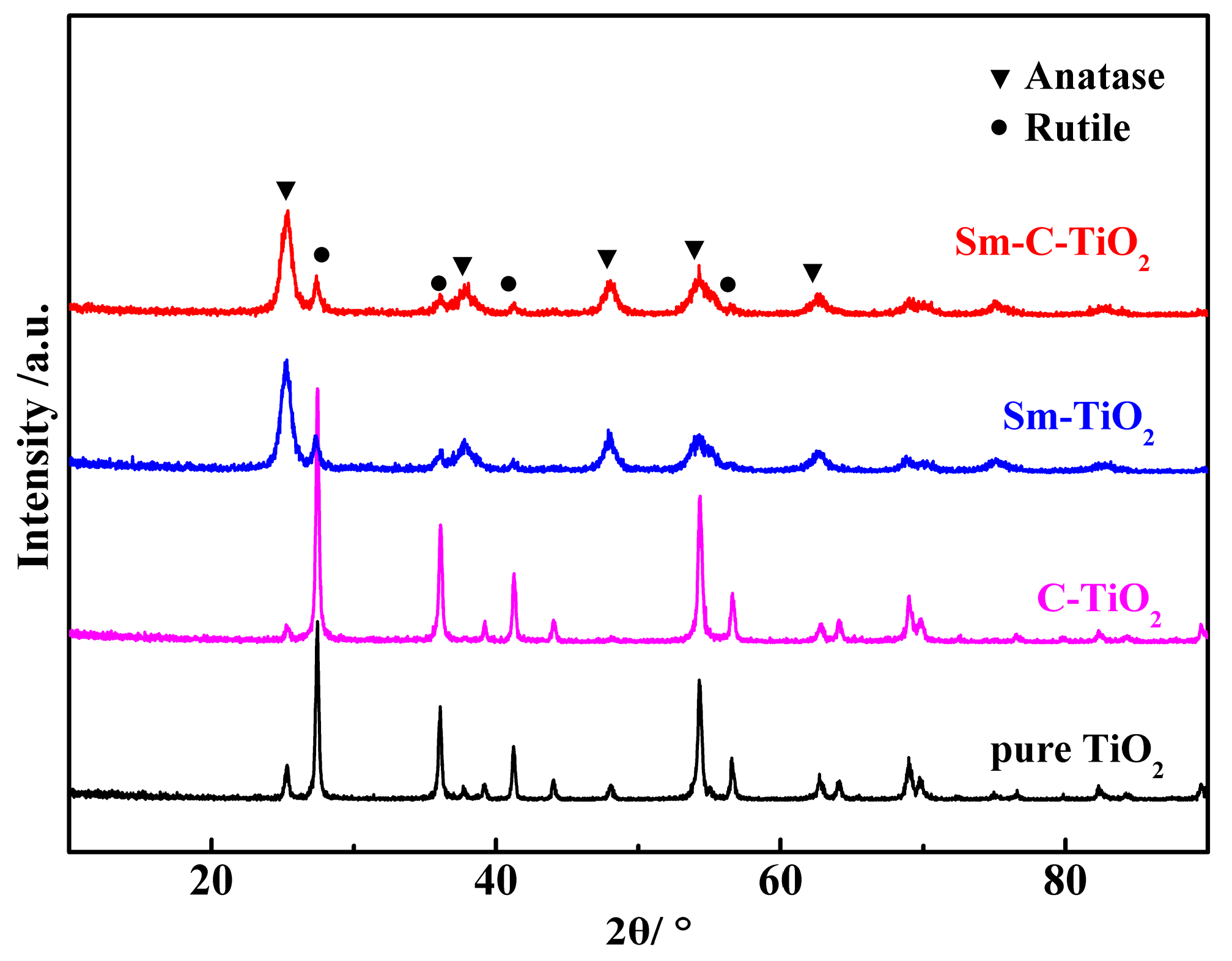
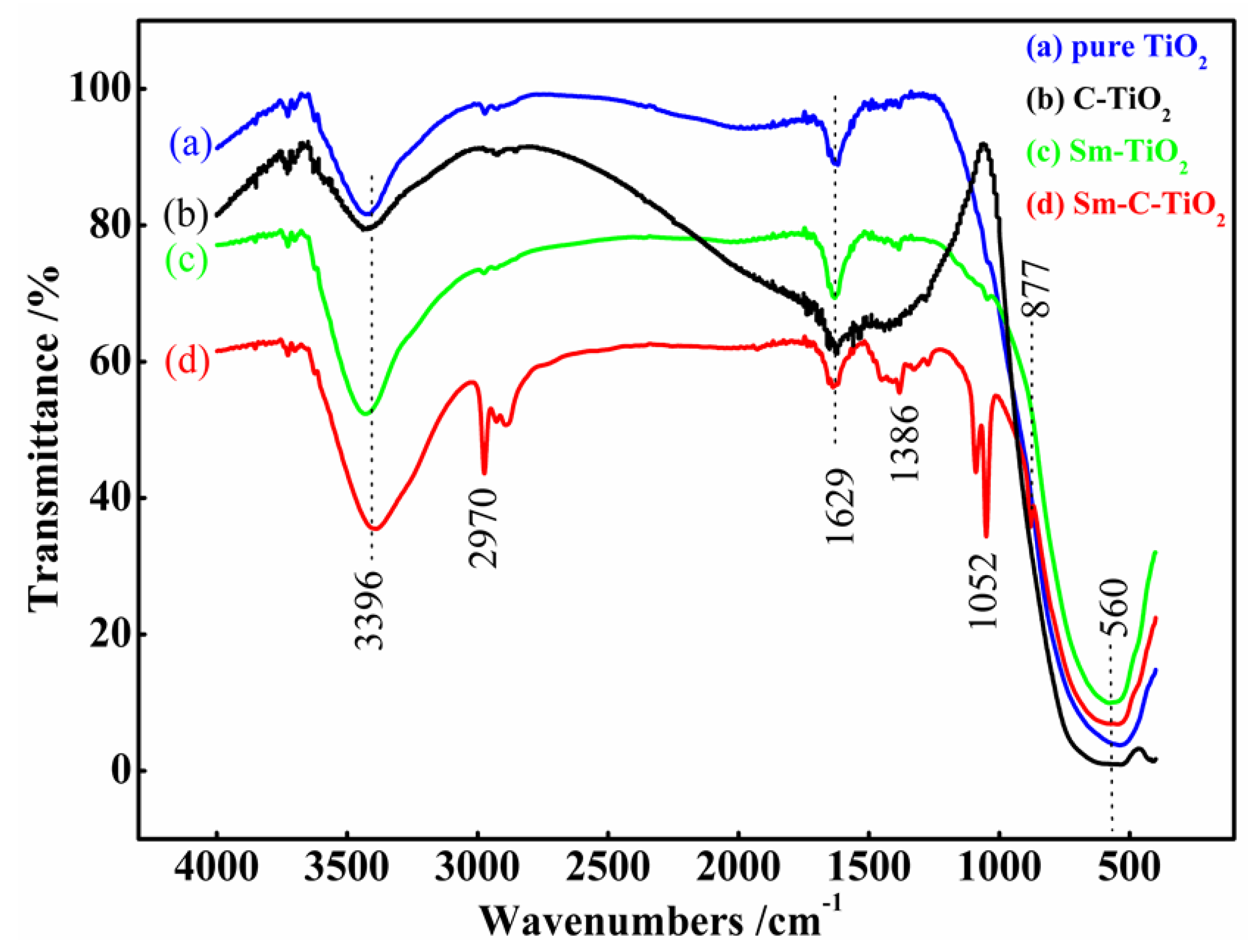
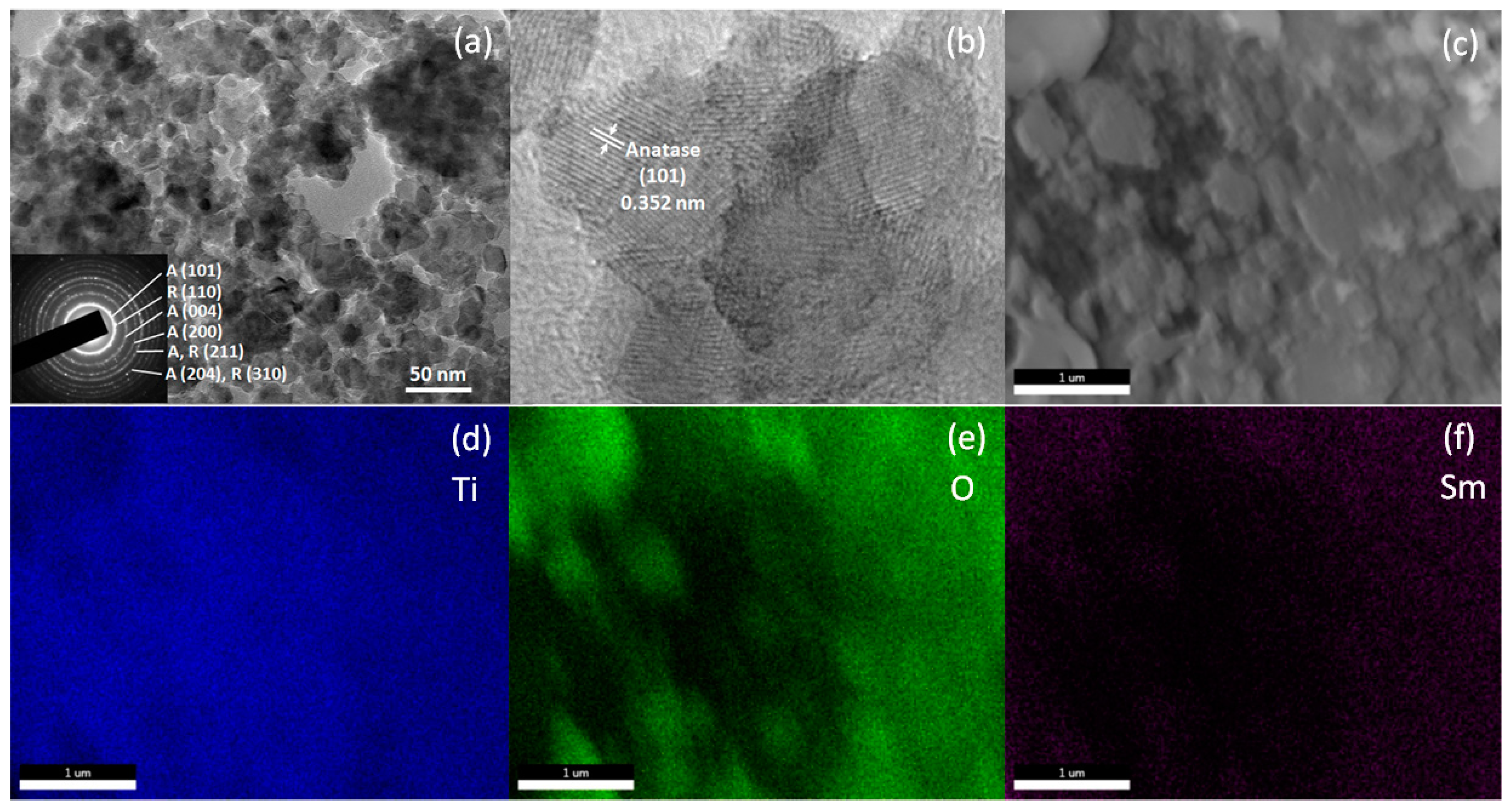
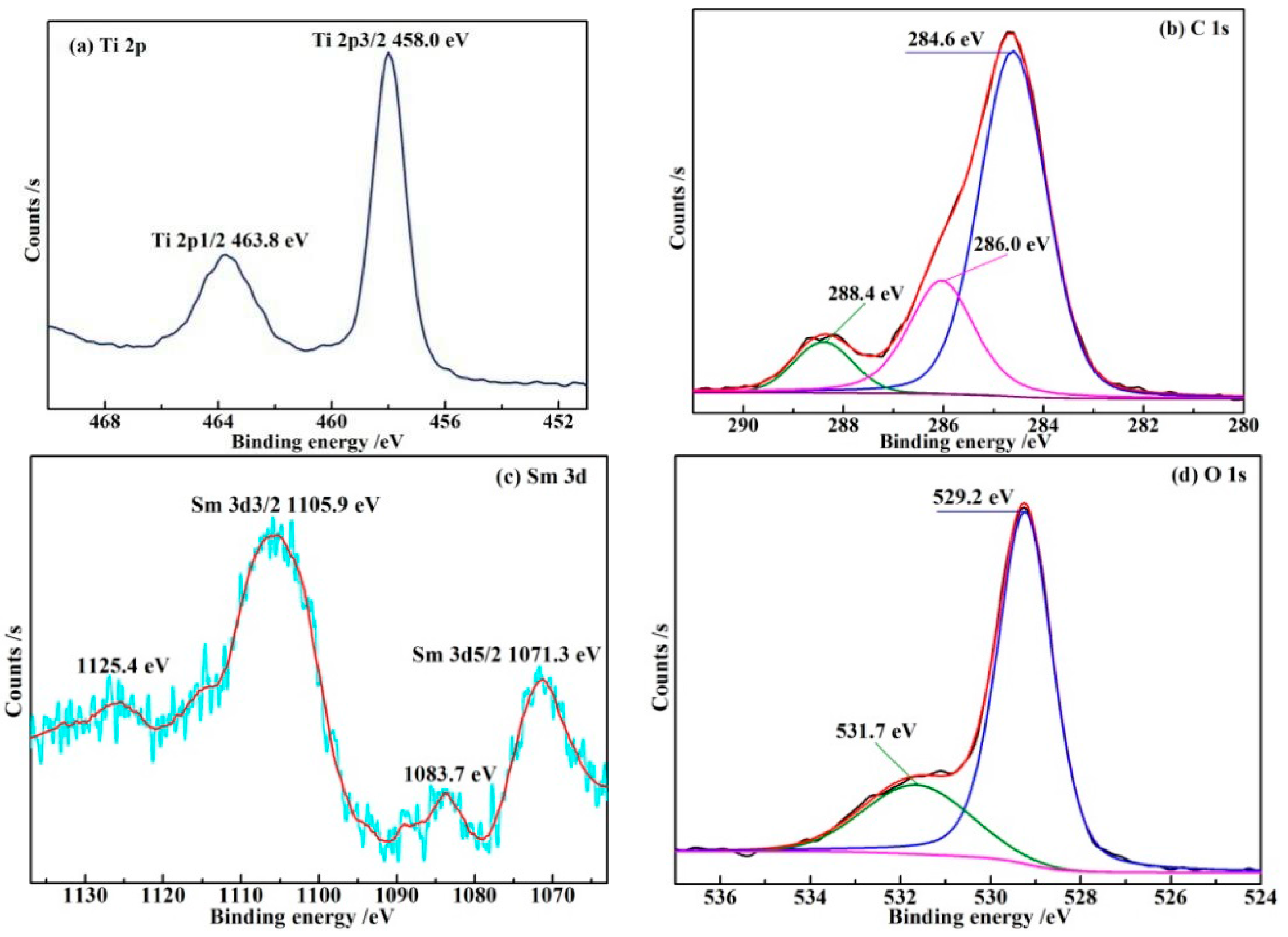

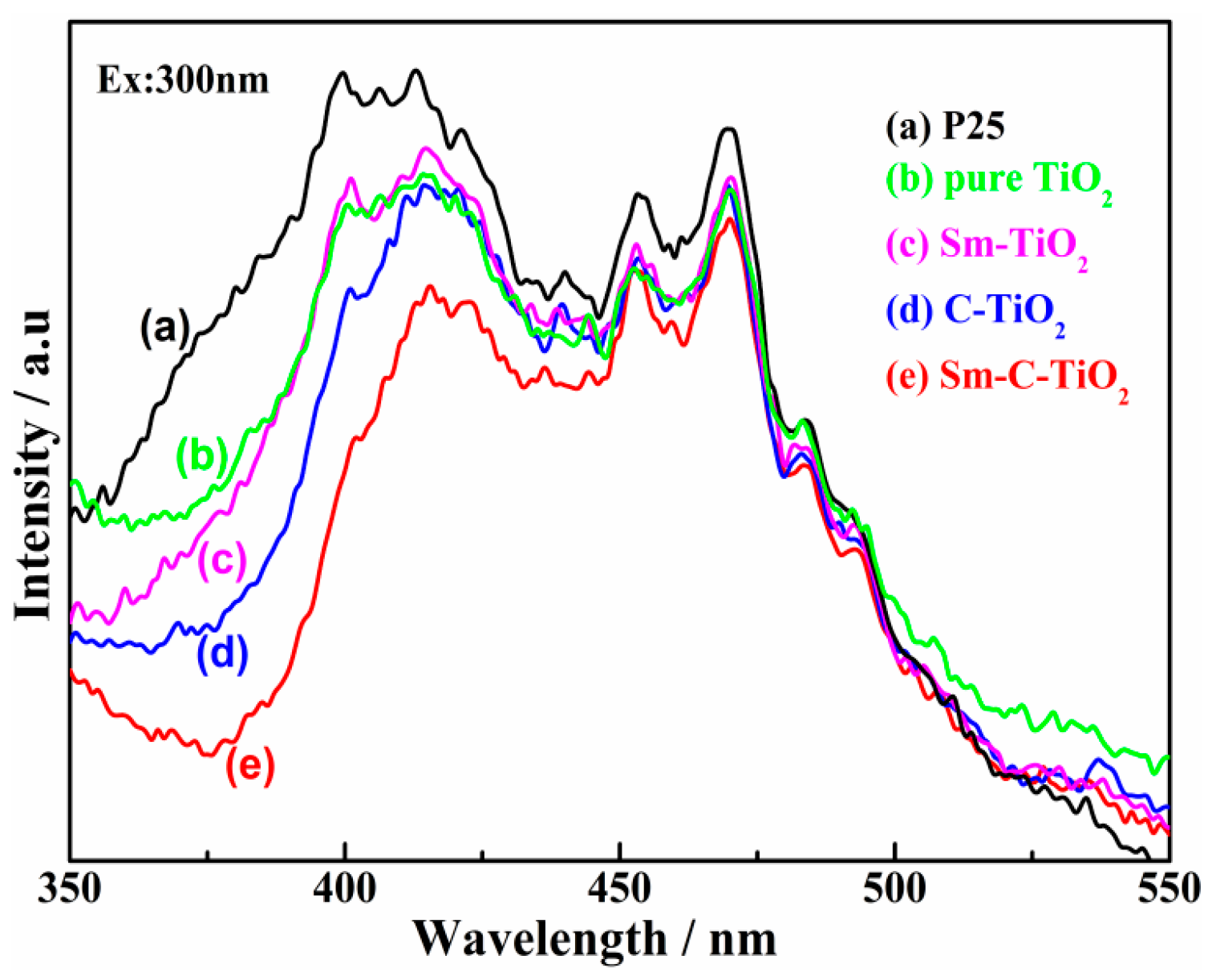
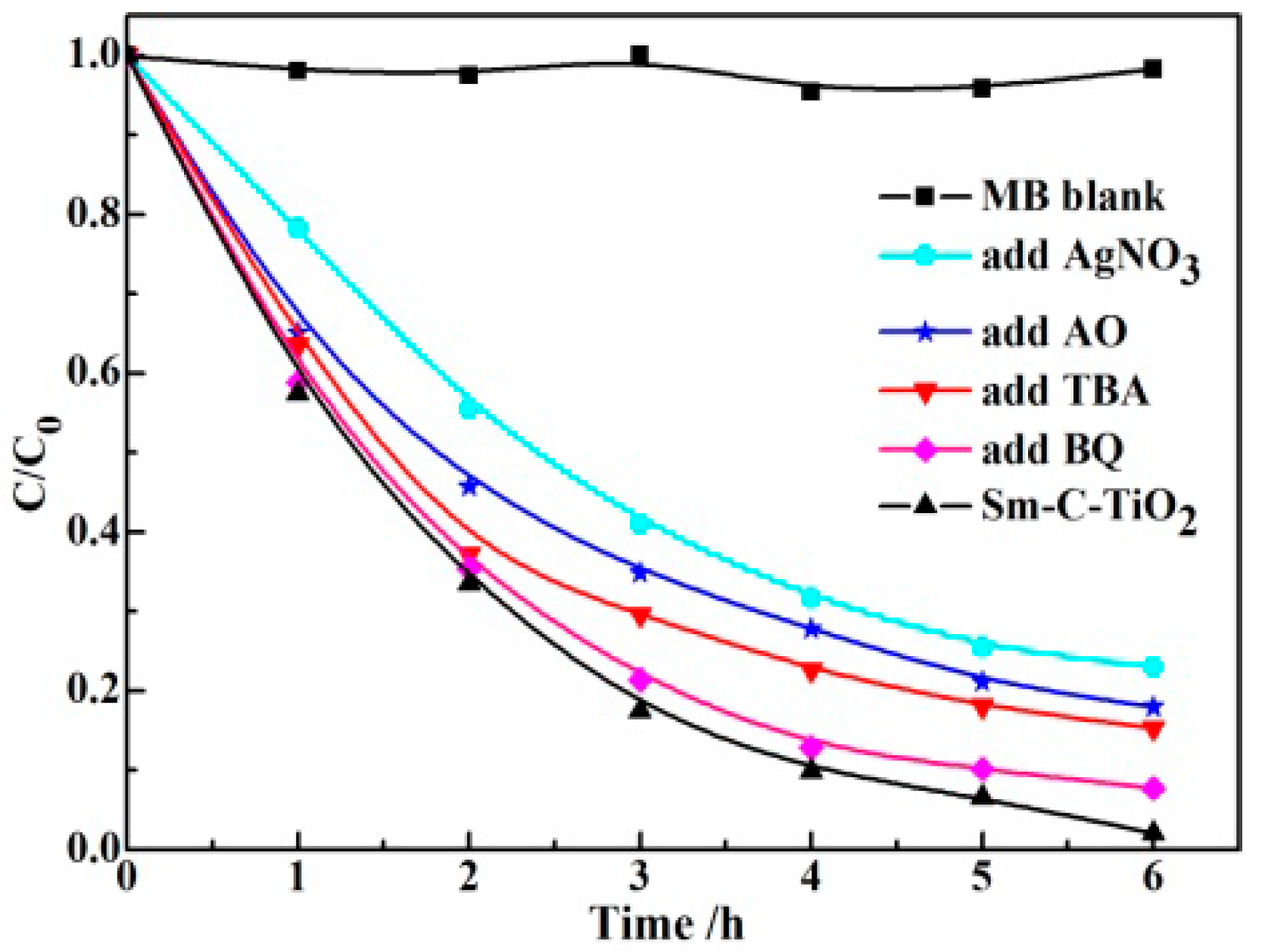
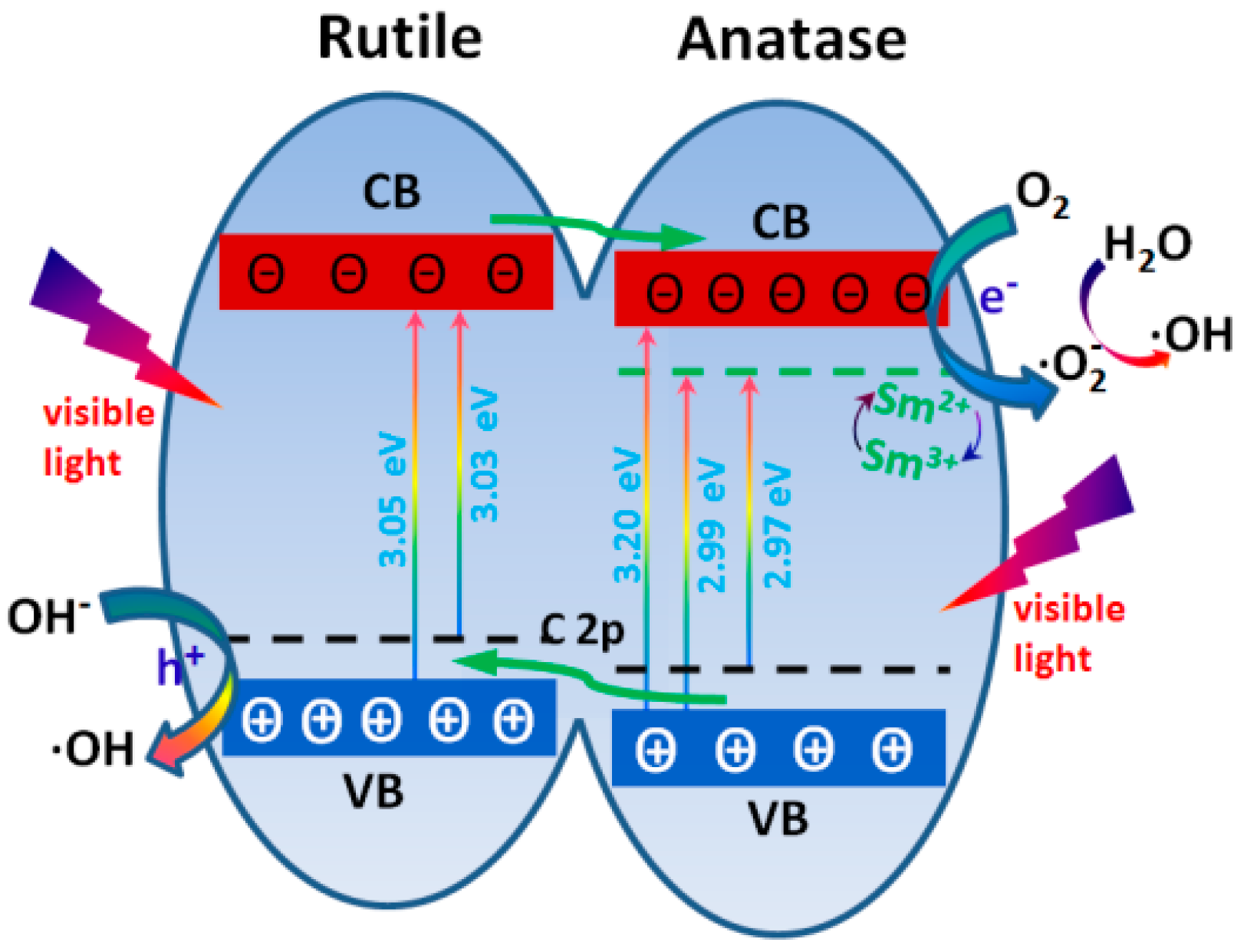
| Samples | Anatase XA (%) a | Crystal Size | Interplanar Spacing | Average Grain Size (nm) | ||
|---|---|---|---|---|---|---|
| DA/nm | DR/nm | d-(101) Å | d-(110) Å | |||
| Pure TiO2 | 12.6 | 29.8 | 31.8 | 3.5145 | 3.2478 | 174 |
| C-TiO2 | 4.0 | 31.7 | 30.5 | 3.5148 | 3.2475 | 143 |
| Sm-TiO2 | 74.3 | 12.1 | 22.0 | 3.5175 | 3.2525 | 58 |
| Sm-C-TiO2 | 70.0 | 11.3 | 25.9 | 3.5092 | 3.2550 | 78 |
© 2017 by the authors. Licensee MDPI, Basel, Switzerland. This article is an open access article distributed under the terms and conditions of the Creative Commons Attribution (CC BY) license ( http://creativecommons.org/licenses/by/4.0/).
Share and Cite
Peng, F.; Gao, H.; Zhang, G.; Zhu, Z.; Zhang, J.; Liu, Q. Synergistic Effects of Sm and C Co-Doped Mixed Phase Crystalline TiO2 for Visible Light Photocatalytic Activity. Materials 2017, 10, 209. https://doi.org/10.3390/ma10020209
Peng F, Gao H, Zhang G, Zhu Z, Zhang J, Liu Q. Synergistic Effects of Sm and C Co-Doped Mixed Phase Crystalline TiO2 for Visible Light Photocatalytic Activity. Materials. 2017; 10(2):209. https://doi.org/10.3390/ma10020209
Chicago/Turabian StylePeng, Fuchang, Honglin Gao, Genlin Zhang, Zhongqi Zhu, Jin Zhang, and Qingju Liu. 2017. "Synergistic Effects of Sm and C Co-Doped Mixed Phase Crystalline TiO2 for Visible Light Photocatalytic Activity" Materials 10, no. 2: 209. https://doi.org/10.3390/ma10020209
APA StylePeng, F., Gao, H., Zhang, G., Zhu, Z., Zhang, J., & Liu, Q. (2017). Synergistic Effects of Sm and C Co-Doped Mixed Phase Crystalline TiO2 for Visible Light Photocatalytic Activity. Materials, 10(2), 209. https://doi.org/10.3390/ma10020209





